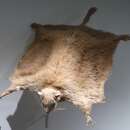en
names in breadcrumbs


The systematic position of Anomalurus derbianus has been greatly debated. They have been grouped with the porcupines, the mouse-related rodents, and the squirrel-related rodents. They are sometimes included in a separate suborder, Anomaluromorphia, and superfamily, Anomaluroida. Although these animals resemble squirrels in external appearance, parts of their internal anantomy indicate no close relationship to squirrels. The little information known about their predecessors helps to further complicate their phylogenetic classification. The longevity of Lord Derby's flying squirrels is estimated to be several years (Grzimek, 1990) (Nowak, 1991).
Perception Channels: tactile ; chemical
Due to the rapid deforestation of their habitat, Lord Derby's flying squirrels are increasingly endangered. No specific protection, however, exists for this species. Any attempts to decrease habitat destruction in Africa will help protect A. derbianus (Grzimek, 1991).
IUCN Red List of Threatened Species: least concern
Lord Derby's flying squirrels are herbivorous, eating a variety of plant products such as bark, fruit, leaves, flowers, and green nuts. Insects are sometimes included in the diet, but this is most likely by accident (Grzimek, 1990) (MacDonald, 1985).
Lord Derby's flying squirrel inhabits the tropical and subtropical forests of western and central Africa.
Biogeographic Regions: ethiopian (Native )
The principle habitat is heavy virgin rainforests (Grzimek, 1990) (Nowak, 1991).
Terrestrial Biomes: rainforest
Anomalurus derbianus are squirrel-like in form and have a head-body length of 27-37.9 cm. Their tail is approximately 22-28.4 centimeters in length. The upper side of the tail is bushy with a hairy tuft at the end. The fur is silvery-grey on its dorsal side, with the ends of individual hairs brushed in white. The fur on the belly is dense and completely white. These color markings blend well against the background of a tree. Lord Derby's flying squirrels have long whiskers, big pouch-like ears, and large eyes. Their digits are well developed and they have strong claws. Anomalurus derbianus possess a hairy gliding membrane that extends between the forelimbs and the hind limbs and between the hind legs and the tail. This membrane is heavily covered with hair on the top, and sparsely covered on the underside. These scaly-tailed squirrels receive their name from the presence of two rows of overlapping scales on the underside of the tail near the base (Grzimek, 1990) (Nowak, 1991) (Rosevear, 1969).
Other Physical Features: endothermic ; bilateral symmetry
In West Africa, the main breeding season of A. derbianus seems to be at the end of the rainy season. In East Africa, however, no definite breeding season is apparent. Females, possessing one pair of teats, have two litters of 1-3 young per year; the gestation period is unknown. At birth, babies are large and completely covered with fur. Their eyes are open, and they begin to move around soon after birth. However, the young remain hidden in the nest until almost fully grown. Offspring are fed by the parents, which bring back well chewed up food in their mouths. (Delany, 1975) (Grzimek, 1990) (MacDonald, 1985).
Key Reproductive Features: gonochoric/gonochoristic/dioecious (sexes separate); sexual